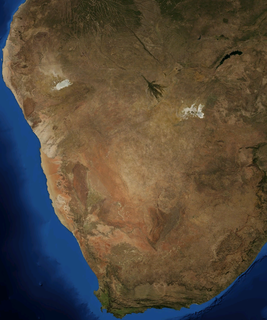
The Kalahari Desert is a large semi-arid sandy savannah in Southern Africa extending for 900,000 square kilometres (350,000 sq mi), covering much of Botswana, and parts of Namibia and South Africa.

Oregano is a flowering plant in the mint family (Lamiaceae). It is native to temperate Western and Southwestern Eurasia and the Mediterranean region.
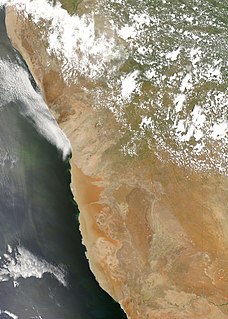
The Namib is a coastal desert in southern Africa. The name Namib is of Khoekhoegowab origin and means "vast place". According to the broadest definition, the Namib stretches for more than 2,000 kilometres (1,200 mi) along the Atlantic coasts of Angola, Namibia, and South Africa, extending southward from the Carunjamba River in Angola, through Namibia and to the Olifants River in Western Cape, South Africa. The Namib's northernmost portion, which extends 450 kilometres (280 mi) from the Angola-Namibia border, is known as Moçâmedes Desert, while its southern portion approaches the neighboring Kalahari Desert. From the Atlantic coast eastward, the Namib gradually ascends in elevation, reaching up to 200 kilometres (120 mi) inland to the foot of the Great Escarpment. Annual precipitation ranges from 2 millimetres (0.079 in) in the most arid regions to 200 millimetres (7.9 in) at the escarpment, making the Namib the only true desert in southern Africa. Having endured arid or semi-arid conditions for roughly 55–80 million years, the Namib may be the oldest desert in the world and contains some of the world's driest regions, with only western South America's Atacama Desert to challenge it for age and aridity benchmarks.

Leucanthemum vulgare, commonly known as the ox-eye daisy, oxeye daisy, dog daisy, marguerite and other common names, is a widespread flowering plant native to Europe and the temperate regions of Asia, and an introduced plant to North America, Australia and New Zealand.

Hoodia is a genus of flowering plants in the family Apocynaceae, under the subfamily Asclepiadoideae, native to Southern Africa.

Cirsium vulgare, the spear thistle, bull thistle, or common thistle, is a species of the Asteraceae genus Cirsium, native throughout most of Europe, Western Asia, and northwestern Africa. It is also naturalised in North America, Africa, and Australia and is an invasive weed in some areas. It is the national flower of Scotland.

Cyphostemma juttae is a slow-growing succulent species of Cyphostemma from southern Africa, well known as an ornamental plant.

Aloidendron dichotomum, formerly Aloe dichotoma, the quiver tree or kokerboom, is a tall, branching species of succulent plant, indigenous to Southern Africa, specifically in the Northern Cape region of South Africa, and parts of Southern Namibia.
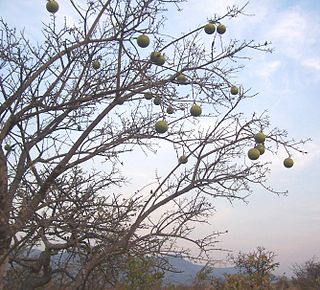
Strychnos spinosa is a tree indigenous to tropical and subtropical Africa. It produces, sweet-sour, yellow fruits, containing numerous hard brown seeds. Greenish-white flowers grow in dense heads at the ends of branches. The fruits tend to appear only after good rains. It is related to the deadly Strychnos nux-vomica, which contains strychnine. The smooth, hard fruit are large and green, ripen to yellow colour. Inside the fruit are tightly packed seeds, which may be toxic, surrounded by a fleshy, brown, edible covering. Animals such as baboon, monkeys, bushpig, nyala and eland eat the fruit. The leaves are a popular food source for browsers such as duiker, kudu, impala, steenbok, nyala and elephant.

Acanthosicyos horridus is an unusual melon that is endemic to the Namib desert. In English it is known as Nara, butter-nuts, or butterpips; in one of the Khoisan languages it is locally called ǃnaras or ǃnara.
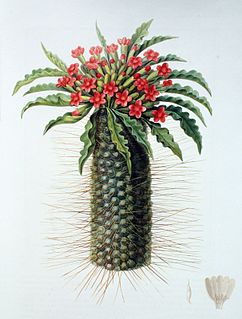
Pachypodium namaquanum, also known as halfmens or elephants trunk, is a succulent plant of Southern Africa. The genus name Pachypodium is from the Greek for 'thick foot', an allusion to its swollen base, while the species name namaquanum is a reference to Namaqualand.

Gonialoe dinteri, the Namibian partridge aloe, is a species of flowering plant in the Asphodelaceae family. It is native to arid areas of Angola and Namibia.

Aloidendron pillansii, formerly Aloe pillansii, the giant quiver tree or bastard quiver tree, is a large, branching species of succulent plant indigenous to southern Africa. It is regarded as critically endangered.

Namaqua National Park is a South African national park situated approximately 495 km north of Cape Town and 22 km northwest of Kamieskroon. It has an area of more than 1300 km2. The park is part of Namaqualand, an area covering 55,000 km2 located within the semi-desert Succulent Karoo biome. This biome is a biodiversity hotspot with the largest concentration of succulent plants in the world. The park also has an arid environment with succulent plants. The park was created to protect its flowers. During the spring, wildflowers bloom there in a spectacular fashion. The park's main tourist attraction is this abundant spring bloom of brightly coloured wildflowers.

Kalahari Acacia-Baikiaea woodlands is an ecoregion located in Botswana, northern Namibia, South Africa and Zimbabwe.

The ǀAi-ǀAis/Richtersveld Transfrontier Park is a peace park straddling the border between South Africa and Namibia. It was formed in 2003 by combining the Namibian ǀAi-ǀAis Hot Springs Game Park and the South African Richtersveld National Park. Most of the South African part of the park forms part of the buffer zone of the Richtersveld Cultural and Botanical Landscape World Heritage Site, which measures 5,920 square kilometres (2,290 sq mi). The Fish River Canyon is located in the park, the largest canyon in Africa. A Memorandum of Understanding was signed on 17 August 2003 by the presidents of South Africa and Namibia, which formalized the establishment of the park. |Ai-|Ais, means ‘burning water’ after the hot springs of the same name.

Vachellia reficiens, commonly known as red-bark acacia, red thorn, false umbrella tree, or false umbrella thorn, is a deciduous tree or shrub of the pea family (Fabaceae) native to southern Africa, often growing in an upside-down cone shape and with a relatively flat crown.

Ornithoglossum is a genus of plants native to southern Africa, some of which are widely cultivated as ornamentals. Nine species are currently recognized, as of April 2014:
Portulacaria armiana, also known as the whipstick-porkbush, is a succulent plant found on the border between Namibia and South Africa.
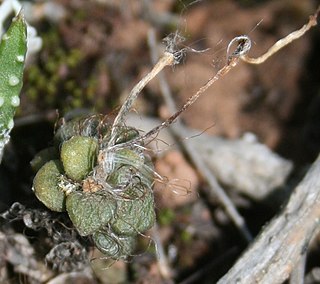
Anacampseros retusa is a species of succulent plant native to the Northern Cape and Western Cape Provinces of South Africa, as well as to Namibia.



















